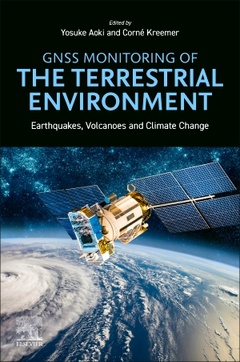GNSS Monitoring of the Terrestrial Environment Earthquakes, Volcanoes, and Climate Change
Coordonnateurs : Aoki Yosuke, Kreemer Corné

GNSS Monitoring of the Terrestrial Environment: Earthquakes, Volcanoes, and Climate Change presents the application of GNSS technologies to natural hazards on Earth. The book details the background theory of the GNSS techniques discussed and takes the reader through applications and implementation. Tables comparing GNSS with other geodetic techniques, such as SAR, VLBI, SLR, and conventional geodetic methods such as strainmeters, tiltmeters, and leveling surveys are also included. The book concludes with a chapter bridging both parts, discussing the relationship between earthquakes, volcanism, and climate change. The book is aimed at academics, researchers, and advanced students working in the fields of remote sensing technologies or natural hazards. It is divided into two parts, with the first covering the monitoring of earthquakes, volcanoes, and applications of GNSS signals to better understand earthquakes and volcanism, while the second part covers monitoring climate change with GNSS.
1. Introduction 2. Technical Aspects of GNSS Data Processing Part I. Monitoring Earthquakes and Volcanoes with GNSS 3. On the Use of GNSS-Inferred Crustal Strain Accumulation in Evaluating Seismic Potential 4. Earthquake Deformation 5. GNSS Observations of Transient Deformation in Plate Boundary Zones 6. Earthquake and Tsunami Early Warning with Global Navigation Satellite System Data 7. Volcano Deformation 8. Ionospheric Seismology and Volcanology Part II. Monitoring Climate Change with GNSS 9. Sea Level Changes 10. Weather and Climate Change Monitoring 11. Monitoring of Extreme Weather: GNSS remote sensing of flood inundation and hurricane wind speed 12. GNSS and the Cryosphere 13. The Role of GNSS Monitoring in Landslide Research 14. Climate and Weather Driven Solid Earth Deformation and Seismicity 15. Influence of Climate Change on Magmatic Process: What does geodesy and modelling of geodetic data tell us?
Corné Kreemer received his Ph.D. degree from Stony Brook University in 2001. He was a postdoctoral fellow until 2004 at the Ecole Normale Superieure, Paris, and the College de France. Since 2004 he is an academic member of the Nevada Geodetic Laboratory in the Nevada Bureau of Mines and Geology at the University of Nevada, Reno. He also has a joint position at Nevada Seismological Laboratory. His primary expertise is in converting GNSS-derived crustal velocities into strain rate and vertical land motion models and relating those results to earthquake occurrence and lithosphere and mantle dynamics. He has also worked on reference frame definitions, several earthquakes, tsunami early warning, and time-series analysis techniques. He is best known as the main contributor to the Global Strain Rate Model. He has published over 75 peer-reviewed articles.
- Provides a detailed focus on the utility of GNSS technologies for dealing with natural hazards
- Details theory and applications of GNSS to natural hazards, allowing readers to develop a thorough understanding on the theoretical background as well as practical applications
- Covers the latest developments in the field, along with future perspectives as GNSS technologies are expected to evolve
Date de parution : 08-2024
Ouvrage de 290 p.
15x22.8 cm
Thème de GNSS Monitoring of the Terrestrial Environment :
Mots-clés :
GNSS; GPS; Earthquakes; Volcanic eruption; Climate change; Sea level change


